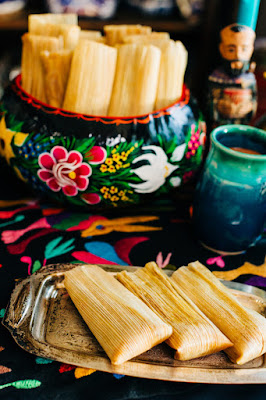Postales del Paraiso
Dia de la Candelaria
If you found a plastic baby Jesus in your King’s Cake on El dia de Los Reyes (Three Kings Day) on January 6ththen listen up! Tradition states that if you get the plastic baby, you are the designated Padrino (Godfather) and get to host the fiesta for everyone on Dia de la Candelaria which is today (Feb. 2) and, among other responsibilities, you have been designated to provide tamales for everyone! Perhaps you should have been paying attention a little earlier, because this is a really big deal (and a lot of work).
Día de la Candelaria, like so many other Mexican celebrations, is a fascinating fusion of pre-Hispanic traditions and Catholic beliefs. It’s a seasonal celebration (midway between the winter solstice and the vernal equinox), an agricultural celebration (the January rains will determine the best time to plant, indeed they’re thought to predict the weather for the entire year), and a couple of religious celebrations (the Feast of the Purification of the Virgin, and the Presentation at the Temple).
In Mexico the baby Jesus is the most important part of the Christmas celebration. On Christmas Eve the baby is placed in the Nativity scene, and on January 6, King’s Day, the child is brought gifts from the Three Kings, and then on February 2nd, the official end of the Christmas season, the figure of the Christ child that has been lying in the manger must be presented at the local church to be blessed in a ceremony that remembers the presentation at the Temple.
But this is not as simple as it sounds. The swaddling clothes that Jesus has been wearing for the past month or so are not the proper attire for this very special occasion. So if you were the lucky one to find a plastic baby Jesus in your Rosca de Reyes on Three Kings Day, then you are the designated “Padrino” (godfather) and must, among various other responsibilities, dress the baby Jesus in the finest of clothes for his big day. The first year the baby is traditionally dressed in white representing El Nino de las Palomas (The Child of the Doves) or El Nino de las Azucenas (The Child of the Lilies), signifying purity. The second year the Baby Jesus is dressed with a blue, yellow or pink gown and the third year, and thereafter, he is dressed according to the preference of the Godparents, but traditionally as the Nino de la Candelaria (Child of the Candles) with a white gown, a candle in the left hand and flowers in the right.
The Padrino also takes candles to the church and in some agricultural communities he will also take a handful of seeds to be blessed and pray for a year of abundant harvest. At the end of the church ceremony the Padrinos take the Christ child back to the home where the Rosca de Reyes was served on Three Kings Day and the candles are lit. Later, in the evening there is a traditional “tamalada” where the tamales are made according to the custom of the place. There are many variations depending on which part of the country you reside, some are sweet, some savory, some are wrapped in corn husks, others in banana leaves, but they are all absolutely delicious! Traditionally these are served with “atole de pinole”, a drink made of a toasted corn meal, sometimes sweetened and mixed with cocoa, cinnamon or aniseed, or “champurrado” (a chocolaty flavored thick drink). What a way to bring the Christmas season to a close!
In addition to The Feast of the Purification of the Virgin and the Presentation of the Christ Child at the Temple, not entirely coincidentally Feb 2nd falls halfway between the winter solstice and the vernal equinox, a date that signaled that it was time to prepare the earth for planting of crops and of course the need to assess the upcoming weather. Celebrated in Ireland, and other European countries as “Imbolc” (or Saint Brigids’s Day) and in the United States as “Groundhogs Day”, there is also a Spanish tradition referred to as "Cabañuelas" but that's another story.








No comments:
Post a Comment